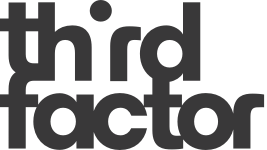A team’s energy comes from within
A while back I was leading a Self-Aware Team program for the coaches and support staff of a team that was preparing to represent Canada at the Winter Games in Beijing. An important part the program is an exercise in which team members create “player cards” containing key insights they’ve learned about themselves through the program. The group then comes together in a Zoom call to share those insights and give and get feedback. Like so many others, this group had been through an incredibly taxing year. Because of the pandemic, the team had to expend significantly more energy than it ordinarily would to create effective training opportunities for the athletes. Quarantines and “bubbling” rules had forced individuals to spend months at a time on the road, adapting to new routines and away from their families. And uncertainty over everything from health and testing to the potential fate of the games loomed over it all.“The ways they brought energy were as diverse as the people themselves.”As the group shared their player cards, it quickly came to light that a number of different members of this team had been significant “energy givers” through this difficult time. And the ways they brought energy were as diverse as the people themselves.
- One senior leader on the team created energy in the more traditional way that many leaders do: by envisioning a compelling opportunity, mapping out a plan to get there and leading the charge towards it.
- Another team member helped bring lightness to the daily grind by noticing and pointing out funny moments, breathtaking views, or interesting aspects of their surroundings. These moments created mini-breaks that relieved tension and reminded the team of the unique and special journey they were on together.
- Another contributor was celebrated for their “can-do attitude.” This individual had a “big personality” with a healthy dose of confidence who led by example and encouragement. Their jokes, positive energy and infectious smile helped the team forge ahead with a belief that they could prevail when they were hit with a setback or success seemed a long way off.
- Yet another had taken on the role of a confidante and created a safe, non-judgmental space for people to bounce ideas, vent frustrations and seek advice when they needed to gain perspective on a situation (or person) that was creating challenges.
Three energizing principles
In listening to the group share their feedback, I was struck by three things: Energy is found in diversity. During the discussion I heard multiple different ways that multiple different people infused the group with energy. Some provided big boosts, other provided steady nudges. Some energized all team members. Others were more critical in sustaining a handful of specific individuals. Some were helpful at the start to get the flywheel moving forward. Others stepped in during negative moments to break tension and redirect focus when forward movement was stalled. Each team member’s contribution could stand on its own, but put together they added up to more than the sum of their parts. Energizing the team is everyone’s responsibility. No single contributor can create enough energy on their own to sustain a team; the demands are simply too vast. Everyone on the team shares some responsibility for energizing their teammates. The team leader’s job is to create the conditions that allow it to happen. Feedback is of key importance. In many cases, the “energy givers” were surprised to learn the value of what they provided. In fact, some had mistakenly believed that the very behaviors that others found energizing were irrelevant or a distraction. If not for the reinforcement they received during the session, many had been planning to curtail some of those behaviors moving forward. And, if that had taken place, then valuable sources of positive energy would have simply faded away because people were unaware.Energize your team
Every leader needs to create an environment that enables their people to perform. And energy is a critical part of that environment. But it’s not the leader’s role to provide that energy all on their own. Instead, the best leaders create the conditions for “energy givers” to thrive.“Create a clear image of what it looks like to be an energy giver.”Start by setting the expectation that energy is a team responsibility. Work with your people to create a clear image of what it looks like to be an “energy giver” and what behaviors will move the team’s energy level in a positive direction. Help your team surface the different ways “energy givers” sustain the team in tough moments. Make it a part of your regular check-ins to ask people what’s contributed to their energy over the past week and encourage open discussion when appropriate. Finally, provide opportunities for regular feedback and recognition so that each “energy giver” knows what to keep doing. This feedback can come from you as a leader, but people should also hear from their peers. Effective feedback recognizes the behavior, communicates its impact, and encourages the person to continue. With this approach, a leader can create more energy on their team than they could ever hope to do alone, while at the same time helping their people to stay engaged and motivated through whatever may come.
Bring the Summer Learning Series to your team • Request a call • Send this page to your manager or HR team
Energize your team as we move out of the pandemic with a series of three, one-hour virtual learning events. The months ahead will present new challenges as business needs change, blended working environments begin to take shape, and leaders are once again forced to adjust to rapid change and uncertainty. Help ready your people to lead and perform through the next phase with a series of virtual learning events.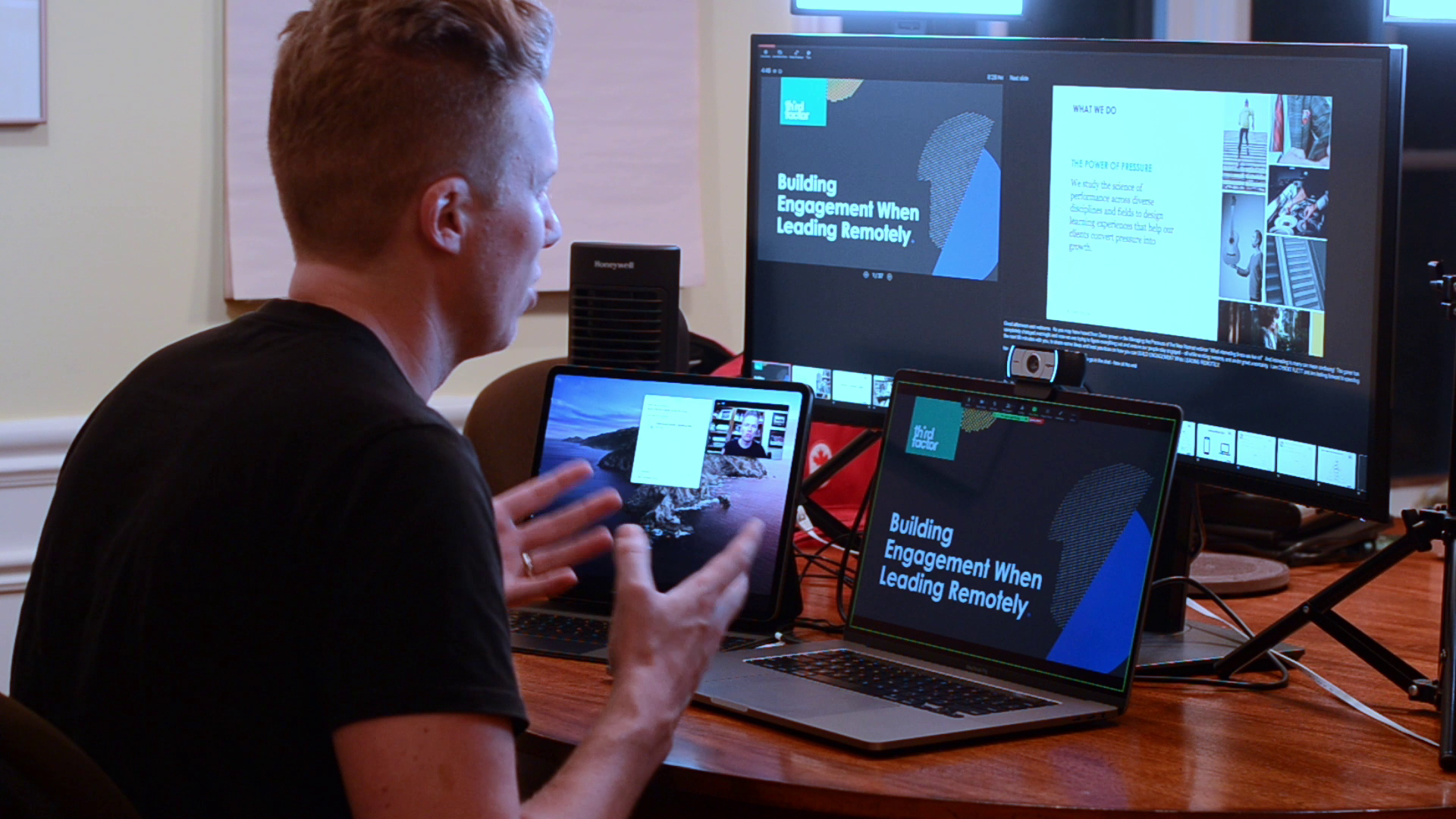
TWO TRACKS TO CHOOSE FROM
Develop your people in the areas that will benefit them most. Choose our leadership track to build your team’s coaching and collaboration capabilities, or choose our resilience track to build your team’s ability to perform under pressure.LEADERSHIP TRACK Develop high performing leaders.
3×4 Coaching
Drawing on a wealth of experience from our 30+ years of working with the world’s top coaches, 3×4 Coaching introduces the 3 Plays and 4 Skills great coaches use to build commitment and get results.Building High-Performing Teams
Basketball coach Roy Rana has built high performing teams at every level from high school to the NBA. Drawing on years of experience, he will share what he has learned about how to create an environment in which a team is more than the sum of its parts.Working With People You Don’t Understand
Introduce participants to the relationship between their mindsets, behaviours and results, and take them on an interactive tour of how adopting new mindsets of curiosity and generosity can make those behaviours automatic.
RESILIENCE TRACK Enhance performance under pressure.
Building Resilience
High performance is not possible without pressure. The Building Resilience keynote introduces a personal resilience toolkit used by elite athletes to develop a relationship with stress and pressure that puts them in the driver’s seat.Maintaining Team Motivation Through the Troughs
When teams face challenging times, leaders have four allies to preserve motivation and fight the tide of disillusionment. This session brings these allies to life with stories from people who have used them under incredible pressure.The Power of Pressure
Drawing insights from his book, The Power of Pressure: Why Pressure isn’t the Problem, it’s the Solution, Dane Jensen’s new keynote address introduces three powerful strategies for using pressure as an advantage.
DELIVERED BY A WORLD-CLASS FACULTY
Our speakers teach at top business schools, have coached Olympic and professional athletes, been Olympic athletes, consulted at the highest level of business, and practiced law. Their strong personalities and unique personal experience draw audiences in and keep learners engaged.LEARN MORE
Want to learn more about bringing our Summer Learning Series to your organization? Leave your contact information below and we’ll get in touch.In this article
Explore our virtual leadership development options to meet your current needs.
One Size Doesn’t Fit All
Depending on your goals for virtual learning, different approaches are required. We’ve taken a ‘small / medium / large’ approach to our product development to meet the needs of a variety of scenarios:Large Group Experiences
Webinars or a-synchronous content to spark ideas and motivation for groups of any size.
Targeted Group Programs
Learning journeys that integrate video, synchronous learning, 1:1 coaching and application to build mastery for up to 49 people.
In-depth Cohort Programs
Half-day interactive instructor-led sessions for up to 18 people to build core skills.
Get the catalog
Download a full summary of our leadership development programs.
Timeless skills + the right tools for right now
Of course, we have a range of virtual options in our core competencies: coaching skills for managers, resilience skills for all, and self-awareness skills to enable more productive collaboration. And, we are continuously launching virtual programs that give learners the skills they need to be successful right now. Note that we are continuously developing new offers (and adapting our in-person programs to virtual delivery) so this list will be updated as new programs come online.Coaching skills for managers

The 3×4 Coaching model explores the 3 plays and 4 skills consistently executed by world-leading coaches.
We have a full range of options for bringing our industry-leading 3×4 Coaching model to life virtually – with a specific eye to how to coach in a virtual environment.In-depth Cohort Programs
3×4 Coaching Virtual Learning Journey
Coaches are leaders who do all they can to help people improve and succeed. It is a way of thinking and interacting with people that communicates high expectations, respect and caring. In this 4 – 6 week (depending on your desired pace) virtual program, individuals learn the concepts and skills of a coaching style of management that builds commitment, drives employee engagement, gets results, and integrates this learning into the flow of their work.
Get a feel for the learning experience in this 3-minute video overview of the program.
Targeted Group Programs
Coaching Remotely 1/2-day Virtual Program
Coaches are leaders who do all they can to help people improve and succeed. It is a way of thinking and interacting with people that communicates high expectations, respect and caring. In this 4 – 6 week (depending on your desired pace) virtual program, individuals learn the concepts and skills of a coaching style of management that builds commitment, drives employee engagement, gets results, and integrates this learning into the flow of their work.
Having Challenging Conversations from a Distance 1/2-day Virtual Program
Our practical, 4-step map for challenging conversations is rooted in our 25 years of experience helping elite athletes manage emotions under intense pressure. Participants explore methods of preparing to confront, learn an effective format for an opening statement, practice managing reactivity and discuss how to close the conversation with accountability built-in.
Large Group Experiences
3×4 Coaching Overview Webinar
Learning coaching skills is the best way to dramatically increase your people’s commitment level and performance. This interactive 1-hour online session starts your powerful coaching journey.
3×4 Coaching Asynchronous Video Program
The 3×4 Coaching Video Program is a self-paced, asynchronous learning journey that unpacks the 3 plays and 4 skills of exceptional coaches. It provides learners with a powerful, easy-to-understand model for coaching people to higher levels of results and engagement.
Watch a brief sample of the 3×4 Coaching video program
Resilience skills for all
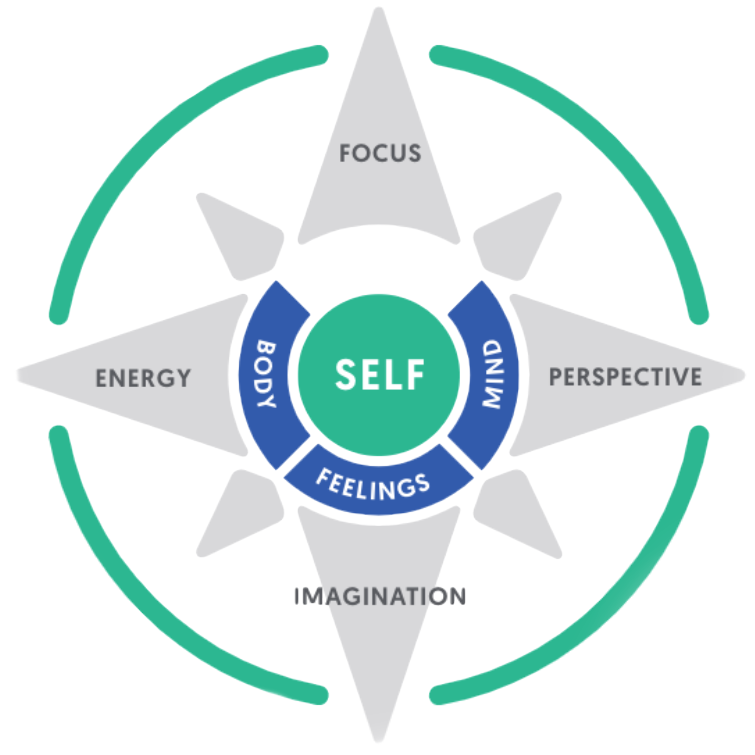
Building Resilience is aimed at giving participants a toolkit of inner skills to navigate their high pressure realities.
Rarely has resilience been as relevant as it is right now. We take our 30+ years of experience in resilience, and bring it to life in a way that gives people the insight and skills needed right now.In-depth Cohort Programs
Building Resilience Virtual Learning Journey
The virtual Building Resilience program synthesizes 30 years of science-backed and performance-proven strategies into a practical toolkit that participants can use to stay healthy under pressure and recover when they are thrown off balance. Our approach to resilience draws on work in elite sport, teaching and research in academia, and work with thousands of people in organizations of all sizes. Building Resilience is a transformative experience that allows participants to learn in the flow of work while changing the way they relate to pressure.
Targeted Group Programs
Building Resilience 1/2-day Virtual Program
A leader’s ability to stay resilient through setbacks and be predictable under pressure is the #1 indicator of how their team will weather the storm. Learn practical techniques for staying even-keeled when it matters most in this 1/2-day online workshop.
Large Group Experiences
Building Resilience Overview Webinar
This online session equips participants with an understanding of how uncertainty and pressure impact their performance and health, an awareness of the choices they have to enhance their resilience under pressure, and a guided, applied exercise that will specifically tackle how they are framing and taking direct action on the areas that will most impact their performance and resilience.
Topical skills leaders need right now

Our Maintaining Team Motivation Through The Troughs program teaches leaders four allies for fighting disillusionment.
A collection of fit-for-purpose programs that address hot button issues like motivation through prolonged periods of uncertainty, challenging conversations from a distance, and the imperative for agility and personal ownership over re-skilling.Targeted Group Programs
Maintaining Team Motivation Through the Troughs 1/2-day Virtual Program
As the pandemic drags on, maintaining motivation and engagement will become a primary challenge for leaders. Learn practical techniques to keep people energized, resilient and motivated, inspired by Olympic coaches and athletes, in this 1/2-day online workshop.
Large Group Experiences
The Meta-Skilled Organization
Meta-skills are the connective tissue that allow people and organizations to let go of the skills that have anchored their successful past and master and embrace new ways of working – in other words, to evolve. Packed with ideas on both how to foster the development of meta-skills for yourself, and how to build meta-skilled organizations as stewards of talent, this keynote lays out a framework for six key meta-skills that allow individuals and organizations to see clearly, move quickly, and stay the course.
Self-awareness & collaboration
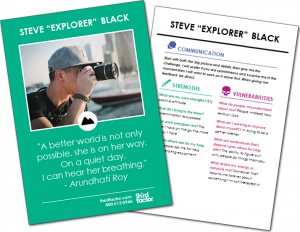
The “player’s card” is one of our favourite tools for helping learners translate self-awareness to communication and action.
Targeted Group Programs
The Self-Aware Leader Virtual Program
The Self-Aware Leader program combines the TAIS assessment, three one-on-one coaching sessions, the creation of a personal action plan to address a real business challenge, an ability to chart your progress and adjust your approach through the guidance of a coach. It will help leaders understand and leverage their strengths under pressure and identify what changes if made, would matter the most.
Large Group Experiences
TAIS Assessment + 1:1 Coaching
Whether you want to build self-awareness for a few executives or all of your people managers, the TAIS can help them identify environments and performance situations in which they will thrive and excel, when and how they are most likely to make mistakes and what they can do to ensure you will perform well under pressure. Participants receive an individual report detailing 18 personal styles as they relate to attention, information, leadership, social and communication and have the opportunity to build further clarity with a 1:1 coaching call.
Let’s talk!
If you’re interested in any the above – or anything that you don’t see here – let’s chat! You can get in touch at hello@thirdfactor.com.Download the catalog.
Get a complete overview of our coaching, collaboration and resilience programs.
In this article:
Three imperatives for L&D during COVID-19
- Leverage technology to continue “regularly scheduled programming.” Lead by example to encourage resilience and agility.
- Build resilience when it matters most. Investing in resilience skills demonstrates empathy and can yield significant benefits even with virtual delivery.
- Use this opportunity to invest in 1:1 coaching. Foster self-awareness and personal development at scale without gathering groups.
“L&D teams can provide unique value and directly influence how the organization weathers the storm”Connecting pressure to personal growth is vital for resilience over the long haul. If, as a leader, I feel like the pressure is just a weight on my shoulders that I must endure, it will have a significantly more negative impact than if I see how rising to this challenge can help me become stronger and better. Growth gives meaning to pressure – and our ability to help people see this tough period as a growth experience is a significant imperative for maintaining engagement at work.
Growth gives meaning to pressure.
Taken together, this makes the coming months a time when L&D teams can provide unique value and directly influence how the organization weathers the storm. The coming months will undoubtedly be a period of great pressure – but how heavy that pressure sits, and how skillfully it is navigated, is within L&D’s circle of influence. By rising to meet this challenge, learning and development organizations can support their risk management teams, build esteem for the department among senior executives, show the ability of the department to deliver in critical moments, directly influence performance outcomes, and directly support an entire workforce through an extremely challenging time. So, how can L&D navigate the choppy waters of risk mitigation policies while seizing the moment to step up and shine? We see three major imperatives:1. Demonstrate agility + resilience – leverage technology to continue “regularly scheduled programing”
Personal growth and development is a major driver of satisfaction and engagement in the workplace. When other drivers of satisfaction and engagement are compromised, continuing to invest in learning is vital. And, as learning organizations – we want to model the behaviours we are asking leaders to engage in: resilience, adaptability and flexibility. If we are asking others in the organization to continue to do their jobs in the face of disruption – it’s up to us to do the same.“Think deliberately about a learning journey that is designed to sustain energy and support application”Depending on the measures in place in your organization, this may include continuing to run in-person programming in small-medium sized groups – perhaps modified to focus on local attendees. In many cases, however, policies will necessitate the conversion of regularly scheduled programming into virtual delivery. Speaking from the perspective of an organization focused entirely on the development of leadership, collaboration and resilience skills – there are two imperatives we see to getting this right:
Think Fortnite, not Netflix
There is a reason in-person, instructor-led training continues to deliver the best learning outcomes: it gives people a chance to engage directly with an expert, to learn from peers, and to debate, dialogue and practice. In short, it’s a participative experience. While it is tempting to replace in-person programming with self-paced programs and video libraries – think Netflix – when it comes to executive function skills like coaching, collaboration, and resilience, getting strong learning outcomes requires collaboration. This is the ‘Fortnite’ model: we’re in this together, working alongside each other, in constant communication, and working towards a common goal.
Think Fortnite, not Netflix – virtual learning should be interactive and participative.
Divide and conquer
With dates already reserved on learners’ calendars, it can seem logistically easy to replace a 1-day in-person program with a 1-day virtual session. Even the most expertly designed and facilitated virtual sessions begin to lose their energy, however, after the two-hour mark. Instead, take advantage of the luxury of dividing learning up into more manageable modules. Freed from the requirements of a group of 25-30 learners traveling to one location for a short period of time, virtual sessions give you the opportunity to think deliberately about a learning journey that is designed to sustain energy and support application. The best designs involve modules that don’t require prolonged periods of attention, include interactivity and discussions that invite participation and reduce the temptation of distraction, and close with a clearly actionable outcome that learners can practice prior to the next module (i.e. an action learning-oriented approach). Virtual instructor-led technology has come a long way in even the past 12 months. In the face of COVID-19 we’ve been working directly with many of our clients to use a technology stack focused on interactivity and collaboration to ‘convert’ their in-person experience into virtual ones – complete with breakout rooms, lively discussion, whiteboard sessions and polling. Take advantage of new technology to demonstrate resourcefulness.2. Build resilience in all corners of your organization
Ultimately, resilience is built in the troughs, not the peaks. And, not only is this a time in which resilience skills are vital – it’s also the perfect time to support your people in building resilience. In my forthcoming book, tentatively titled The Power of Pressure, I argue that the two key factors that ramp up pressure are importance (“this matters to me”) and uncertainty (“I don’t know how this will turn out”). The threat posed by COVID-19 delivers an unhealthy dose of both these ingredients.
Changing policies and sparsely populated offices are just two sources of uncertainty.
In the face of this pressure, learning and development teams have an opportunity to show that the organization cares not just about physical safety but also about people’s psychological wellbeing, and stands ready to help them learn the skills they need to not just survive but thrive through this period. There are two key imperatives here:Support physical resilience
Employee wellness programs have never been more important than they are right now. Sleep, nutrition and exercise are the basis of not just a healthy immune system but also a resilient individual. Now is the time to promote awareness of the programs available to your teams.Build inner resilience
Resilience isn’t a genetic gift – it’s a set of skills that can be learned and mastered. Often we assume that resilience will be built naturally as a by-product of tough times – but just like an athlete needs a good coach to reap the developmental benefits of sport, so too do individuals need support in learning how to channel pressure into growth.“In times of challenge, what’s often most challenging is that the old pressure doesn’t go away”In our Building Resilience program, we do this by giving participants an understanding of how uncertainty and pressure impact their performance and health, and then grow their awareness of the choices they have and skills they can use to enhance their resilience under pressure. I led a 90-minute virtual session on resilience for leaders at a major cruise line last week. As you can imagine, the pressure they are facing is immense. In our opening exercise, I asked them to identify the things that make this “interesting times” for them. Here is a random sample of the 46 responses I received:
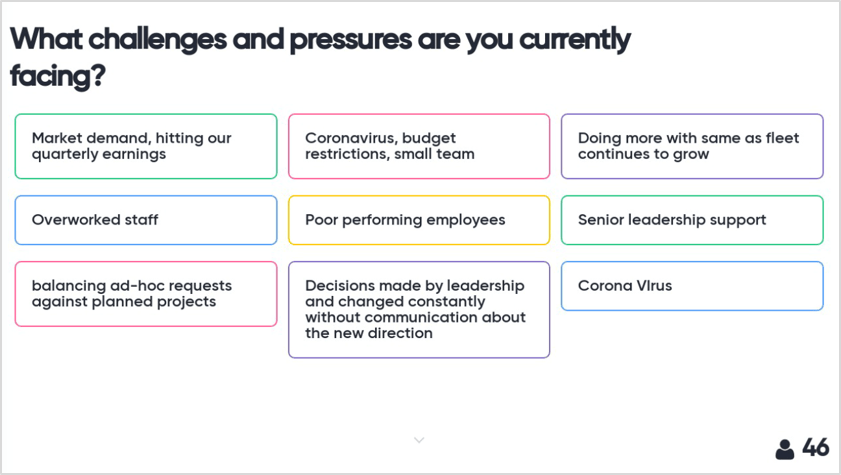 What’s most interesting to me is that the responses weren’t simply “coronavirus” 46 times. In times of challenge, what’s often most challenging is that the old pressure doesn’t go away – we simply add more to the pile, further compounding our already high-pressure lives.
In acute scenarios such as this one, people need to have a clear sense of:
What’s most interesting to me is that the responses weren’t simply “coronavirus” 46 times. In times of challenge, what’s often most challenging is that the old pressure doesn’t go away – we simply add more to the pile, further compounding our already high-pressure lives.
In acute scenarios such as this one, people need to have a clear sense of:
- What they can control – i.e. their perspective + their behaviours
- What they need to let go of – i.e. the situation + others’ responses

With the right tools, everyone can emerge knowing they were up to the challenge.
3. Give People the 1:1 Learning They Crave (Without Breaking the Bank)
“The next few months provide a real opportunity for learning organizations to invest in the 1:1 learning that people crave”All of the research into learning tells us that providing individualized, coaching is among the best ways to help people learn, achieve their goals, and feel satisfied with their progress. And yet, the cost of providing individualized coaching is often prohibitive at scale. The next few months provide a real opportunity for learning organizations to invest in the 1:1 learning that people crave. The travel challenges posed by the COVID-19 threat will mean a dramatic reduction in travel expenses, and 1:1 coaching is uniquely suited to virtual delivery. Taken together, this provides an opportunity to invest in personalized coaching for your high potential talent at a cost that’s similar to what you would spend on a per-person basis to bring people together for a workshop. Depending on how your organization calculates the overall cost-benefit of leadership development, reduced time away from the field for participants can also support your case for making this kind of investment. So, how do you do this effectively? Two ideas:
1 goal, 3 months
Unlike traditional executive coaching, which is often an open-ended partnership between a coachee and a coach, have people pick a meaningful goal in conjunction with their coach and give them 3 months of support to move towards it. Framing coaching around time-bounded outcomes makes for more deliberate, action-oriented partnerships, gives you a measuring stick for demonstrating ROI to the organization, and ensures that you don’t add on-going cost into your budget.Build self-awareness + self-responsibility
As we all know, adults don’t change because a coach tells them to. They do it because they develop the self-responsibility to change. In our experience, the best way to build self-responsibility in a short period of time is to kick off a coaching partnership with a strong self-assessment tool. We use a tool called The Interpersonal and Attentional Styles Inventory (TAIS) that lends itself perfectly to this kind of individualized development. The TAIS was originally developed for Olympic athletes to better understand their tendencies under pressure and make conscious strategic decisions about how to play to their strengths and compensate for their weaknesses. It was then adopted by the US Navy SEALS for the same purpose and is now very highly regarded in the business community as a tool for building self-awareness and high performance in the corporate environment. The TAIS looks at 18 different metrics to help people understand how they are most likely to behave under pressure and how their unique traits compare to their teammates and contemporaries. As an example, the TAIS results may show that someone has high needs for control – that is, they are less comfortable with uncertainty and like to have a clear view of what’s coming. In the current climate, this tendency has the potential to create significant additional strain for both the individual and anyone they lead as they attempt to exert control in a situation that is largely impossible to influence. Working with a TAIS coach in a one-on-one coaching call, the employee can gain a better understanding of how that tendency is likely to manifest and develop strategies for mitigating its impact. By combining the online TAIS assessment with one-on-one video coaching, you can create an opportunity for your high performing talent to gain a better understanding of themselves, adapt more readily to changes in their environment, and actually enhance their learning through the downturn rather than merely mitigate the impact.Team Canada Captain Hayley Wickenheiser shares her TAIS experience.
Want to Learn More?
Your opportunity to make an important contribution to your organization over the coming months is a brief one and you will need to move quickly to succeed. We are committed to supporting you in seizing this moment and readying the workforce for a period of disruption. If you want to get started right away, we have two turn-key ways for you to roll out 1:1 virtual coaching, and resilience skill-building. For your executive team, mid-senior leadership and high-potential employees, we offer TAIS self-assessments and coaching calls that can be scaled for teams of all sizes and begin delivering to participants in a matter of days. For teams and business units that are most affected by your organization’s COVID-19 response, we are offering an adapted version of our Building Resilience program, delivered entirely online and available in a modular format comprising 1 to 5 modules. Give us a shout if you’d like to know more. For further reading on some of the subjects discussed here, we have a few whitepapers that are especially relevant.- The Why, What and How of Self-Awareness introduces the concept of “active awareness”, a skill that helps you leverage self-awareness in the moment, and that has worked for the thousands of executives Third Factor has worked with.
- The Paradox Of Pressure explores what causes us to feel pressure, explores what happens to the human body and mind when we experience pressure, and looks at ways to transform pressure into growth.
- The Meta-Skilled Organization lays out a framework for individuals and organizations who want to direct their own evolution and claim an uncertain future.
